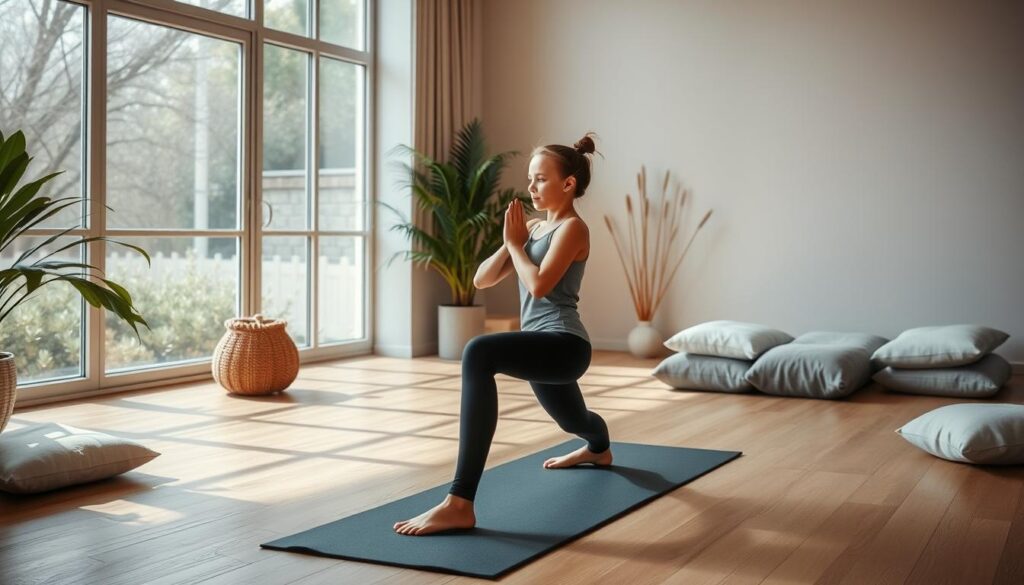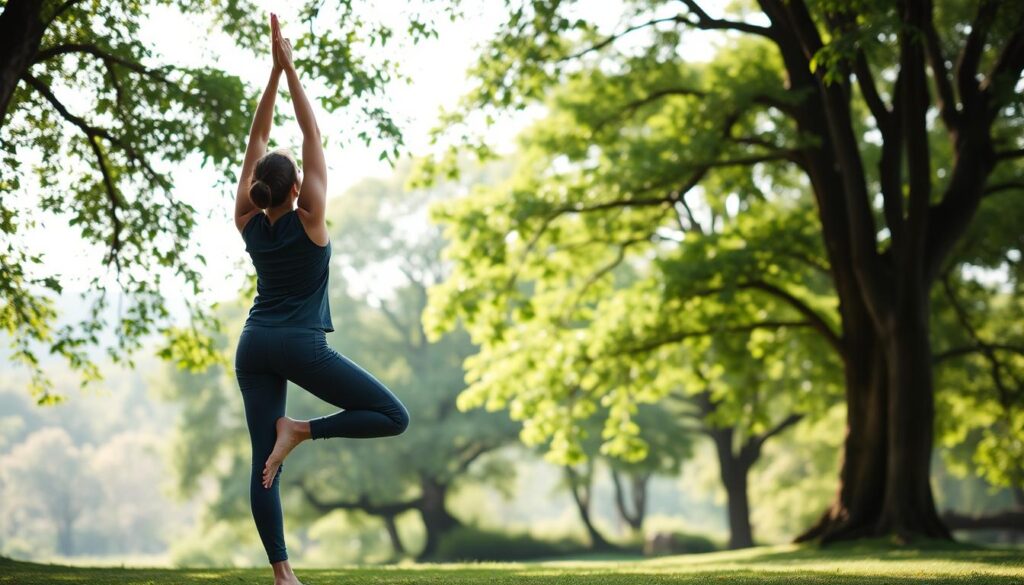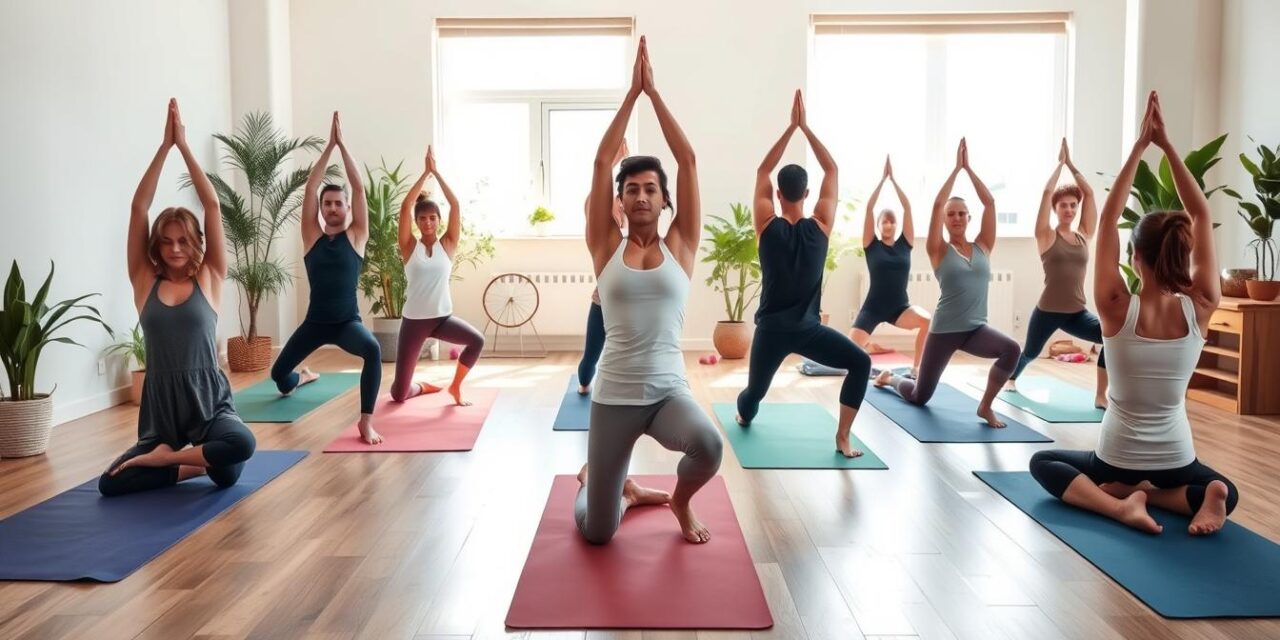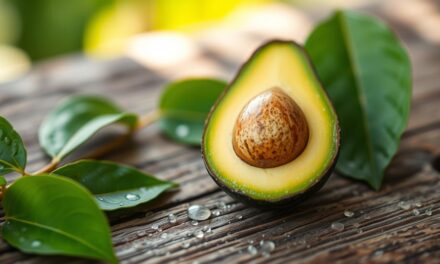Imagine changing your body and mind with just 10 simple yoga poses. In Australia, over 2.4 million people have started yoga. They’ve seen better flexibility, strength, and mindfulness. This article will show you the basic yoga poses for beginners. It will help you start a journey to better health and well-being.
Key Takeaways
- Discover the 10 essential yoga poses that every beginner should master
- Understand the physical and mental benefits of a consistent yoga practice
- Learn the proper alignment and technique for each basic yoga pose
- Gain confidence to build a regular yoga routine tailored to your needs
- Explore modifications and variations to make the poses accessible for all levels
Understanding the Foundations of Yoga Practice
Yoga is an ancient practice that improves physical, mental, and spiritual health. For beginners, knowing the basics is key. This section will cover the essential elements for a fulfilling yoga journey.
Benefits of Regular Yoga Practice
Yoga offers many benefits for your well-being. It improves flexibility, strengthens muscles, and enhances balance and posture. It also reduces stress and boosts heart health. Simple yoga stretches and exercises can bring physical and mental renewal.
Essential Equipment for Beginners
Choosing the right gear is crucial for your yoga practice. You’ll need a good yoga mat for comfort and grip. Wear clothes that are comfy and let you move freely. Blocks, straps, and blankets can also help with poses and your experience.
Safety Guidelines and Precautions
Yoga is safe, but beginners should follow safety tips. Always listen to your body and don’t overdo it. Proper form is key to avoid injuries. If you have health concerns, talk to a yoga expert or doctor first.
Learning the basics of yoga sets you up for a rewarding journey. With the right mindset, gear, and safety, you can enjoy yoga’s benefits. It will nourish your body, mind, and spirit through beginner-friendly stretches and routines.
Mountain Pose (Tadasana): The Starting Point
Mountain Pose (Tadasana) is the first step in many standing yoga poses. It’s a simple yet powerful pose that sets the stage for a balanced yoga practice. As a beginner, Tadasana is key to building a strong foundation for your yoga journey.
To get into Mountain Pose, stand with your feet hip-width apart and toes slightly outward. Feel the ground beneath your feet and connect with the earth. Engage your core, pull your navel in slightly, and stretch your spine up towards the sky.
Keep your shoulders relaxed and your arms by your sides with palms facing forward. This pose has many benefits. It improves your posture and body alignment. It also helps you feel stable and balanced, as you learn to evenly distribute your weight.
Moreover, Tadasana helps you find calm and focus, making it a great starting point for your yoga practice.
As you delve deeper into beginner yoga poses, always come back to Mountain Pose. Mastering this pose will give you a solid base for your yoga practice. It prepares your body and mind for more challenging poses ahead.
Downward-Facing Dog (Adho Mukha Svanasana)
The Downward-Facing Dog pose, or Adho Mukha Svanasana, is a key yoga pose for beginners. It strengthens the upper body and stretches the hamstrings and calves. It also boosts flexibility and balance.
Proper Hand and Foot Placement
To do the Downward-Facing Dog right, start by placing your hands shoulder-width apart. Spread your fingers wide and press into your palms. Then, step back with your feet, keeping them hip-width apart.
Lift your hips up towards the ceiling. This will form an inverted “V” shape with your body.
Common Alignment Mistakes
- Allowing the heels to lift off the mat
- Rounding the shoulders or back
- Locking the knees
Modifications for Beginners
If you’re new to yoga, here are some tips to make the Downward-Facing Dog easier:
- Bend your knees slightly to reduce the stretch in your hamstrings
- Place your feet closer together to create a more stable base
- Bring your heels closer to the floor by placing a folded blanket or block under them
Remember, the key to a successful yoga practice is to listen to your body. Make adjustments as needed. With regular practice and patience, you’ll soon enjoy the full benefits of the Downward-Facing Dog pose.
Child’s Pose (Balasana): Your Resting Position
Child’s Pose, or Balasana, is a key resting pose in gentle yoga. It’s perfect for beginners looking to relax and recharge. This pose helps you find peace when you’re tired or need a break.
To do Child’s Pose, start by kneeling on the mat. Your knees should be apart and your big toes together. As you fold forward, place your forehead on the mat and stretch your arms out.
“Child’s Pose is a wonderful way to catch your breath, reset your mind, and find a moment of peace during your yoga journey.”
Child’s Pose is not just for resting. It also helps you transition between harder poses. It lets you regain your energy and balance. This makes your yoga practice more harmonious.

So, when you need a break, try Child’s Pose. Let your body relax, your mind calm, and your spirit refresh. It’s a great way to start your gentle yoga journey.
Yoga Poses Basic: Building Your Practice
Starting your yoga journey needs a strong foundation. We’ll cover the key parts to build a safe and effective practice. This includes breathing techniques, alignment principles, and tips for progressing.
Breathing Techniques
Proper breathing is vital in yoga. Learning simple exercises like the three-part breath and alternate nostril breathing is essential. These techniques improve focus, relaxation, and lung health.
Proper Alignment Principles
Alignment is key in yoga to ensure safety and benefits. Knowing how to position your body is crucial. It helps you do poses correctly, improving stability and control.
Progressive Practice Tips
- Begin with basic poses and move to harder ones as you get better.
- Practice regularly, even for a few minutes daily, to see progress.
- Adjust poses to suit your body to avoid injury and find what works for you.
- Add variations and challenges to keep your practice exciting and help you grow.
The yoga journey is lifelong. By focusing on these basics, you’ll build a rewarding practice.
Warrior I (Virabhadrasana I)
The Warrior I pose, or Virabhadrasana I, is a key standing yoga pose. It tests your strength and flexibility. This pose not only makes your legs stronger but also boosts your balance and focus.
To do Warrior I right, stand with your feet 3-4 feet apart. Your right foot should face forward, and your left foot turned 45-60 degrees. Make sure your right heel lines up with your left foot’s arch, and your feet are grounded.
- Inhale and lift your arms up, reaching for the sky.
- Engage your core and bend your right knee slowly. Aim for a 90-degree angle, with your knee over your ankle.
- Keep your left leg straight, with your left heel on the ground.
- Look up at your hands, keeping your spine long and neutral.
The yoga poses for flexibility in Warrior I stretch your hips, chest, and shoulders. The basic yoga positions also work your quadriceps, gluteals, and inner thighs. This pose is great for balance and focus, making it perfect for beginners.
| Benefits of Warrior I | Muscles Engaged |
|---|---|
| Strengthens the legs | Quadriceps, Hamstrings, Gluteals |
| Improves balance and focus | Core, Stabilizers |
| Opens the hips, chest, and shoulders | Hip Flexors, Chest, Shoulders |
“Warrior I is a powerful standing pose that cultivates strength, balance, and focus. It’s a foundational asana that helps build a strong, stable yoga practice.”
Cat-Cow Stretch (Marjaryasana-Bitilasana)
Yoga for beginners often starts with the Cat-Cow Stretch. It’s a gentle flow that helps loosen the spine. This stretch is perfect for warming up before more challenging poses.
Spinal Movement Benefits
The Cat-Cow Stretch lets the spine move freely. It arches the back in Cow Pose and rounds it in Cat Pose. This movement boosts posture, eases back pain, and improves spinal health.
Coordinating Breath with Movement
- As you inhale, slowly arch your back and lift your chin, moving into Cow Pose.
- As you exhale, round your spine and tuck your chin, transitioning into Cat Pose.
- Coordinate this gentle spinal movement with your breath, creating a smooth, rhythmic flow.
Linking the Cat-Cow Stretch to your breathing deepens the mind-body connection. It’s a great way for beginners to enjoy the benefits of yoga stretches and easy yoga exercises.
Tree Pose (Vrksasana): Finding Balance
Learning to balance is crucial in yoga. Tree Pose, or Vrksasana, is a great start. It strengthens your legs and improves your focus and body awareness.
To start Tree Pose, stand with your feet apart. Move your weight onto your left leg. Lift your right foot and place it on your left inner thigh, calf, or ankle.
- Engage your core muscles to maintain balance.
- Extend your arms overhead, palms pressed together, or place your hands on your hips.
- Gaze at a fixed point in front of you to improve your focus and stability.
Hold the pose and focus on your breath. Slow, deep breaths help you stay balanced. If you’re shaky, lightly touch your right foot to the ground.
Tree Pose does more than balance. It also strengthens your legs, ankles, and core. It improves your posture and focus. It’s a great addition to your yoga poses basic routine.

Mastering Tree Pose takes time and patience. Don’t worry if you wobble at first. With practice and a bit of beginner yoga pose guide, you’ll stand tall and balanced like a tree.
Bridge Pose (Setu Bandha Sarvangasana)
Bridge Pose, or Setu Bandha Sarvangasana, is a gentle backbend. It strengthens the back, opens the chest, and improves spinal flexibility. It’s a great choice for beginners to improve their yoga poses for flexibility and build a solid foundational yoga postures practice.
Back-Bending Safety
When doing Bridge Pose, focus on proper technique and alignment. Start by engaging your core muscles to support your spine. Keep your shoulders down and away from your ears.
Avoid arching your back too much. Instead, lift your hips towards the ceiling while keeping your neck neutral.
Core Engagement Tips
- Activate your glutes and hamstrings to lift your hips off the mat.
- Engage your abdominal muscles to stabilise your spine and prevent over-arching.
- Breathe deeply, allowing your diaphragm to expand and support your backbend.
By using these core engagement techniques, you’ll stretch your chest and shoulders more. You’ll also protect your lower back from strain. Regular practice of Bridge Pose can make your yoga poses for flexibility better and your foundational yoga postures practice stronger and more balanced.
“Backbends like Bridge Pose are a beautiful way to open the heart and expand the chest, but it’s important to approach them with care and respect for your body’s unique needs and limitations.”
Conclusion
In this guide, we’ve covered the key yoga poses for beginners. We’ve looked at poses like Mountain Pose and Downward-Facing Dog. Each pose is explained to help you build a strong yoga base.
Learning these yoga asanas for beginners boosts your flexibility and strength. It also helps you become more mindful and calm.
As you start your yoga journey, be patient and kind to yourself. Add these simple yoga routines to your daily routine. You’ll see many benefits, like better well-being and stress handling.
Yoga is a journey of self-discovery. It offers deep rewards for your body, mind, and spirit. This guide has given you the tools to start your yoga adventure.
Let these poses guide you as you explore yoga’s many benefits. They will be your companions on this journey of growth and discovery.





